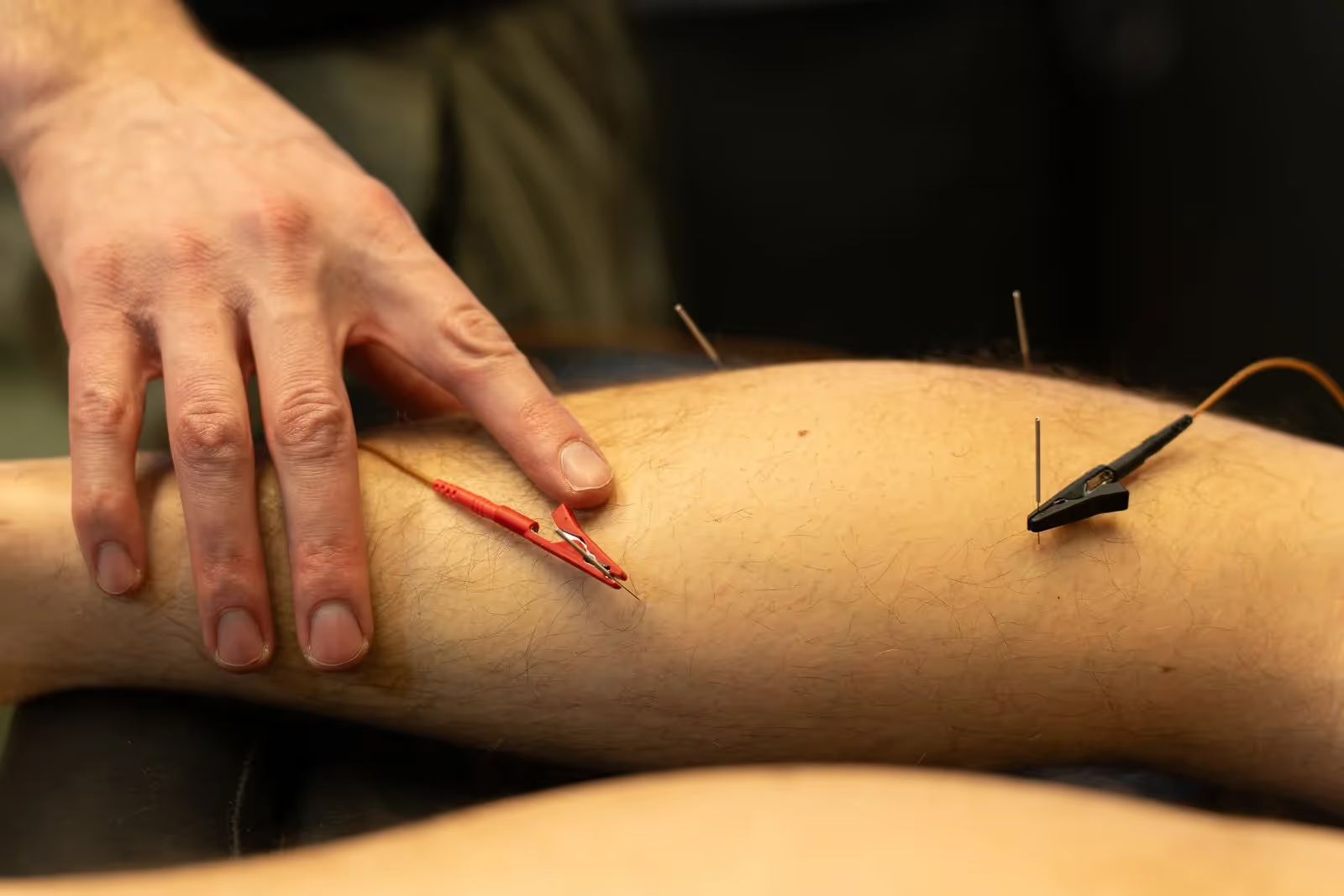Dry needling is a skilled, evidence-based technique used by physical therapists to treat muscle pain and dysfunction. It involves inserting thin, sterile needles directly into trigger points—tight, irritated bands of muscle that can cause pain or limit movement. While it might resemble acupuncture in appearance, dry needling is rooted in Western medicine and focuses specifically on musculoskeletal conditions.
READ: The Connection Between Dry Needling and Improved Mobility
Primary Goal of Dry Needling
The purpose of dry needling is to relieve tension and restore normal muscle function. When a needle is inserted into a trigger point, it can elicit a local twitch response—an involuntary contraction that helps release the muscle. This reaction increases blood flow, reduces inflammation, and allows the surrounding tissue to move more freely. For patients dealing with chronic tightness, restricted range of motion, or persistent pain, this technique can be an effective tool in their recovery process.
Unlike passive treatments, dry needling is often paired with active rehab strategies. At Performance Project PT, it’s commonly used to prepare the body for movement, speed up recovery, and improve overall performance—especially for active individuals and athletes in the South Denver area.
READ: How Dry Needling Can Relieve Chronic Pain for South Denver Residents

Dry needling is most effective when used as part of a comprehensive treatment plan to address musculoskeletal dysfunction. At Performance Project PT, we often use it to support patients dealing with the following:
Neck and Shoulder Pain
Tightness in the upper trapezius, levator scapulae, or rotator cuff muscles often leads to stiffness and limited mobility. Dry needling helps release these trigger points, relieving pain and restoring normal function.
Lower Back Pain
Whether due to poor posture, lifting mechanics, or overuse, lower back tension is a frequent complaint. Dry needling targets deep spinal stabilizers and surrounding muscle groups to reduce pain and improve mobility.
Tension Headaches
These headaches frequently stem from chronic muscle tightness in the neck and shoulders. Dry needling can reduce muscular tension and decrease the intensity and frequency of these headaches.
Sports-Related Injuries
Athletes often use dry needling to manage common issues such as hamstring strains, calf tightness, or IT band irritation. It’s particularly helpful when combined with movement retraining and strength work.
Functional Movement Restrictions
When a muscle is overactive or shortened, it can create faulty movement patterns. Dry needling can help relax and reset the muscle so corrective exercises are more effective.
READ: From Injury to Victory: How Performance Project PT Fuels Colorado Athletes’ Comebacks
How Often Should You Get Dry Needling?
The ideal frequency of dry needling sessions depends on your specific condition, how your body responds, and your overall goals. There's no one-size-fits-all schedule—but there are some general guidelines we use at Performance Project PT.
Acute Conditions
For acute muscle tightness or recent injuries, dry needling might be recommended 1–2 times per week for a short period—typically 2–3 weeks. The goal is to interrupt pain cycles quickly and restore function.
Chronic Pain or Long-Term Issues
Patients dealing with chronic issues may benefit from weekly sessions over a longer duration. This allows for gradual progress and gives the nervous system time to adapt to the changes in muscle tone and movement quality.
Performance or Preventive Care
If you're an athlete or someone who trains regularly, dry needling can also be used proactively. Some clients schedule it every few weeks or monthly to maintain mobility, reduce injury risk, and optimize performance.
Personalized Treatment Plans
At our Centennial clinic, no treatment plan is cookie-cutter. Your PT will assess how you respond after the first one or two sessions and adjust the frequency accordingly. In many cases, as symptoms improve, visits become less frequent and are eventually phased out altogether.
What to Expect After a Session
Understanding what happens after a dry needling session helps set realistic expectations and supports a smoother recovery process. While everyone responds a little differently, there are a few common experiences most patients share.
Mild Soreness Is Normal
You may feel a deep, aching soreness in the treated area for 24–48 hours after your session. This is completely normal—it’s a sign that the needle triggered a local twitch response and initiated the body’s healing process.
Temporary Fatigue or Heaviness
Some patients report feeling tired or experiencing a heavy sensation in the treated muscles. This typically resolves within a day and is often followed by a noticeable increase in mobility or pain relief.
Reducing Post-Treatment Discomfort
To minimize any discomfort:
- Keep moving throughout the day with gentle activity
- Stay hydrated
- Use heat (not ice) on sore areas if needed
Your physical therapist will give you specific post-session instructions tailored to your treatment plan.
When to Be Cautious
If you experience unusual symptoms—such as increased pain that doesn't subside, dizziness, or skin irritation—contact your PT. These are rare, but it's always best to check in if something feels off.
Dry needling is a safe and controlled technique, especially when performed by a licensed and experienced professional like those at Performance Project PT. Understanding the short-term effects can make you feel more confident and comfortable as part of your recovery journey.
READ: The Ultimate Guide to Dry Needling in South Denver: How It Works, Benefits, and What to Expect
What Makes Dry Needling at Performance Project PT Different?
At Performance Project PT in Centennial, CO, dry needling isn’t just a standalone service—it’s a targeted tool used within a holistic, performance-focused treatment plan. Our goal isn’t just to reduce pain temporarily, but to help you move better, feel stronger, and get back to doing what you love.
Expert Care from Skilled Clinicians
Every dry needling session is performed by a licensed physical therapist with advanced training in musculoskeletal assessment and neuromuscular techniques. This ensures that needling is applied safely and effectively, with a clear understanding of how it fits into your broader recovery goals.
Integrated with Movement and Strength Work
We don’t believe in passive care. Dry needling is often paired with mobility drills, strength training, and manual therapy to support long-term improvements in how your body moves. Whether you're recovering from an injury or pushing your athletic performance, our approach goes beyond symptom relief.
Personalized for Your Needs
Your body, your sport, your lifestyle—all of these influence how you respond to treatment. That’s why we tailor each plan to fit your goals. Some patients need just a few sessions, while others benefit from ongoing support as they train or recover.
READ: Centennial’s Guide to Sports Performance: Building a Better Athlete with Physical Therapy
Local, Trusted, and Focused on Results
Located in the heart of Centennial and serving the greater South Denver area, our clinic is built around personalized attention and measurable outcomes. We’re not a high-volume facility. We’re here to build long-term relationships with people who value performance, function, and proactive care.
If you’re curious about whether dry needling is right for you, we invite you to reach out or schedule a consultation. We’re here to help you move forward with confidence.
